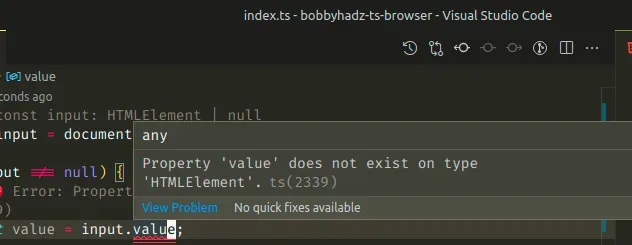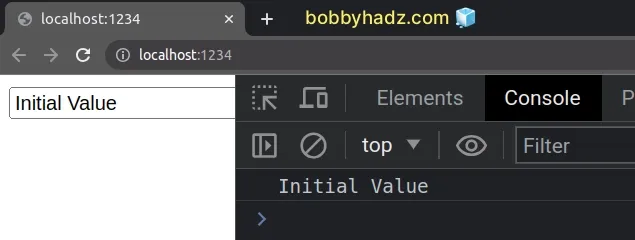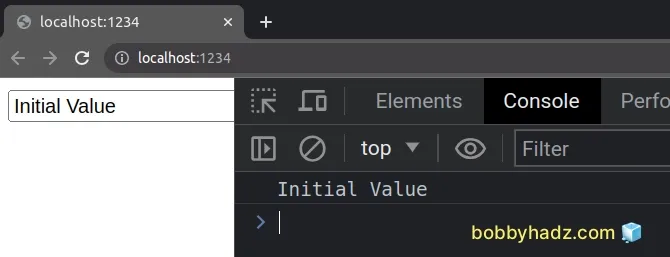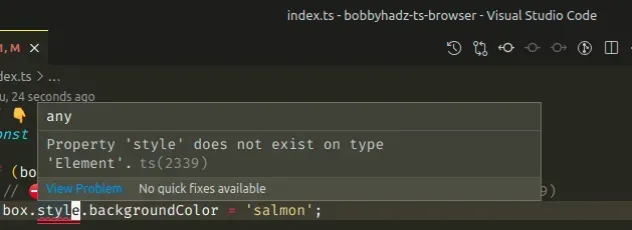Property 'value' does not exist on type 'HTMLElement' in TS
Last updated: Feb 28, 2024
Reading time·7 min

# Table of Contents
- Property 'value' does not exist on type 'HTMLElement' in TS
- (React) Property 'value' does not exist on type HTMLElement
- Property 'style' does not exist on type 'Element' in TS
# Property 'value' does not exist on type 'HTMLElement' in TS
The error "Property 'value' does not exist on type 'HTMLElement'" occurs when
we try to access the value property on an element that has a type of
HTMLElement.
To solve the error, use a type assertion to type the element as
HTMLInputElement before accessing the property.

This is the index.html file for the examples.
<!DOCTYPE html> <html> <head> <meta charset="UTF-8" /> </head> <body> <input id="first_name" type="text" name="first_name" value="Initial Value" /> <script src="./src/index.ts"></script> </body> </html>
And here is an example of how the error occurs in the index.ts file.
// 👇️ const input: HTMLElement | null const input = document.getElementById('first_name'); if (input != null) { // ⛔️ Error: Property 'value' does not exist on type 'HTMLElement'.ts(2339) const value = input.value; }
The reason we got the error is that
the return type of the
document.getElementById method is
HTMLElement | null and the
value property doesn't exist in
the HTMLElement type.
# Use a type assertion to solve the error
To solve the error, use a type assertion to type the element as an
HTMLInputElement (or HTMLTextAreaElement if you're typing a textarea
element).
const input = document.getElementById('first_name') as HTMLInputElement | null; if (input != null) { const value = input.value; console.log(value); // 👉️ "Initial value" }

Type assertions are used when we have information about the type of a value that TypeScript can't know about.
input variable stores anHTMLInputElement or a null value and not to worry about it.We used a union type to specify
that the variable could still be null, because if an HTML element with the
provided id does not exist in the DOM, the getElementById() method returns a
null value.
We used a simple if statement that serves as a
type guard to make sure the input
variable doesn't store a null value before accessing its value property.
const input = document.getElementById('first_name') as HTMLInputElement | null; // 👉️ input has type HTMLInputElement or null here if (input != null) { // 👉️ input has type HTMLInputElement here const value = input.value; console.log(value); // 👉️ "Initial value" }
input variable has a type of HTMLInputElement in the if block and allows us to directly access its value property.# Using the optional chaining (?.) operator
You might also use the
optional chaining (?.) operator to
short-circuit if the reference is equal to null or undefined
const input = document.getElementById('first_name') as HTMLInputElement | null; // 👇️ using optional chaining (?.) const value = input?.value; console.log(value); // 👉️ Initial value

The optional chaining operator short-circuits returning undefined if the
reference is equal to null or undefined.
In other words, if the input variable stores a null value, we won't attempt
to access the value property on null and get a runtime error.
For example as HTMLInputElement, HTMLButtonElement, HTMLAnchorElement,
HTMLImageElement, HTMLTextAreaElement, etc - depending on the type of
element you are working with.
The types are consistently named as HTML***Element. Once you start typing
HTML.., your IDE should be able to help you with autocomplete.
// ✅ Property value const input = document.getElementById('input') as HTMLInputElement | null; if (input != null) { const value = input.value; console.log(value); } // --------------------------- // ✅ Property href const link = document.getElementById('link') as HTMLAnchorElement | null; if (link != null) { const href = link.href; console.log(href); } // --------------------------- // ✅ Property disabled const btn = document.getElementById('btn') as HTMLButtonElement | null; if (btn != null) { btn.disabled = true; } // --------------------------- // ✅ Property focus const input2 = document.querySelector('#first_name') as HTMLElement | null; if (input2 != null) { input2.focus(); } // --------------------------- // ✅ Property checked const input3 = document.getElementById('subscribe') as HTMLInputElement | null; if (input3 != null) { input3.checked = true; }
It's always a best practice to include null in the type assertion because the
getElementById() method would return null if no element with the provided
id was found.
# (React) Property 'value' does not exist on type HTMLElement
The React.js error "Property 'value' does not exist on type 'HTMLElement'"
occurs when we try to access the value property on an element that has a type
of HTMLElement.
To solve the error, use a type assertion to type the element as
HTMLInputElement before accessing the property.

Here is an example of how the error occurs.
import {useEffect} from 'react'; export default function App() { useEffect(() => { const input = document.getElementById('message'); // ⛔️ Property 'value' does not exist on type 'HTMLElement'.ts(2339) console.log(input?.value); }, []); return ( <div> <input id="message" defaultValue="Initial value" /> </div> ); }
We got the error because the return type of the
document.getElementById
method is HTMLElement | null and the value property doesn't exist in the
HTMLElement type.
# Use a type assertion to solve the error
To solve the error, use a type assertion to type the element as an
HTMLInputElement (or HTMLTextAreaElement if you're typing a textarea
element).
import {useEffect} from 'react'; export default function App() { useEffect(() => { // ✅ type element as HTMLInputElement const input = document.getElementById('message') as HTMLInputElement; console.log(input?.value); // 👉️ "Initial value" }, []); return ( <div> <input id="message" defaultValue="Initial value" /> </div> ); }
You can also use a type assertion inline, right before accessing the value
property.
import {useEffect} from 'react'; export default function App() { useEffect(() => { // 👇️ inline type assertion const value = (document.getElementById('message') as HTMLInputElement).value; console.log(value); }, []); return ( <div> <input id="message" defaultValue="Initial value" /> </div> ); }
Type assertions are used when we have information about the type of a value that TypeScript can't know about.
input variable stores anHTMLInputElement and not to worry about it.If you are working with a textarea element, you would use the
HTMLTextAreaElement type instead.
# Using a union type
If you want to be more precise with the type, you can use a
union to set the type to
HTMLInputElement | null.
import {useEffect} from 'react'; export default function App() { useEffect(() => { // ✅ type element as HTMLInputElement | null const input = document.getElementById('message') as HTMLInputElement | null; console.log(input?.value); // 👉️ "Initial value" }, []); return ( <div> <input id="message" defaultValue="Initial value" /> </div> ); }
The HTMLInputElement | null type is correct because if an element with the
provided id does not exist in the DOM, the document.getElementById() method
returns a null value.
Notice that we used the
optional chaining (?.)
operator to short-circuit if the reference is nullish (null or undefined).
input variable stores a null value, we won't attempt to access the value property on null and get a runtime error.You can also use a simple if statement that serves as a type guard to make
sure the input variable doesn't store a null value.
import {useEffect} from 'react'; export default function App() { useEffect(() => { const input = document.getElementById('message') as HTMLInputElement | null; if (input != null) { console.log(input.value); // 👉️ "Initial value" } }, []); return ( <div> <input id="message" defaultValue="Initial value" /> </div> ); }
input variable has a type of HTMLInputElement in the if block and allows us to directly access its value property.It's always a best practice to include null in the type assertion because the
getElementById method would return null if no element with the provided id
was found.
# Property 'style' does not exist on type 'Element' in TS
The error "Property 'style' does not exist on type 'Element'" occurs when we
try to access the style property on an element that has a type of Element.
To solve the error, use a type assertion to type the element as HTMLElement
before accessing the property.

This is the index.html file for the examples.
<!DOCTYPE html> <html> <head> <meta charset="UTF-8" /> </head> <body> <div id="box">bobbyhadz.com</div> <script src="./src/index.ts"></script> </body> </html>
And here is an example of how the error occurs in the index.ts file.
// 👇️ const box: Element | null const box = document.querySelector('#box'); if (box != null) { // ⛔️ Property 'style' does not exist on type 'Element'.ts(2339) box.style.backgroundColor = 'salmon'; }
The reason we got the error is that the return type of the
document.querySelector method is
Element | null and the style
property doesn't exist on the Element type.
# Use a type assertion to solve the error
To solve the error, use a type assertion to type the element as an
HTMLElement.
const box = document.querySelector('#box') as HTMLElement | null; if (box != null) { box.style.backgroundColor = 'salmon'; }
# Use HTMLCollectionOf with getElementsByClassName
If you used the
document.getElementsByClassName
method, type the collection as HTMLCollectionOf<HTMLElement>.
// 👇️ with getElementsByClassName // type as HTMLCollectionOf<HTMLElement> const boxes = document.getElementsByClassName( 'box', ) as HTMLCollectionOf<HTMLElement>; for (let i = 0; i < boxes.length; i++) { boxes[i].style.backgroundColor = 'salmon'; }
We could have also used the more specific HTMLDivElement type because we are
typing a div element.
Type assertions are used when we have information about the type of a value that TypeScript can't know about.
box variable stores anHTMLElement or a null value and not to worry about it.We used a union type to specify
that the variable could still be null, because if an HTML element with the
provided selector does not exist in the DOM, the querySelector() method
returns a null value.
# Using an if statement as a type guard
We used a simple if statement that serves as a
type guard to make sure the box
variable doesn't store a null value before accessing its style property.
// 👇️ const box: Element | null const box = document.querySelector('#box') as HTMLElement | null; // 👉️ box has type Element or null here if (box != null) { // 👉️ box has type Element here box.style.backgroundColor = 'salmon'; }
box variable has a type of HTMLElement in the if block and allows us to directly access its style property.It's always a best practice to include null in the type assertion because the
querySelector() method would return null if no element with the provided
selector was found.
# Additional Resources
You can learn more about the related topics by checking out the following tutorials:
- Add a Click event listener to a Button in TypeScript
- How to Add a class to an Element in TypeScript
- Set CSS styles on an Element using TypeScript
- How to use document.querySelector() method in TypeScript
- Property 'X' does not exist on type 'EventTarget' in TS
- Type 'HTMLElement or null' is not assignable to type in TS

